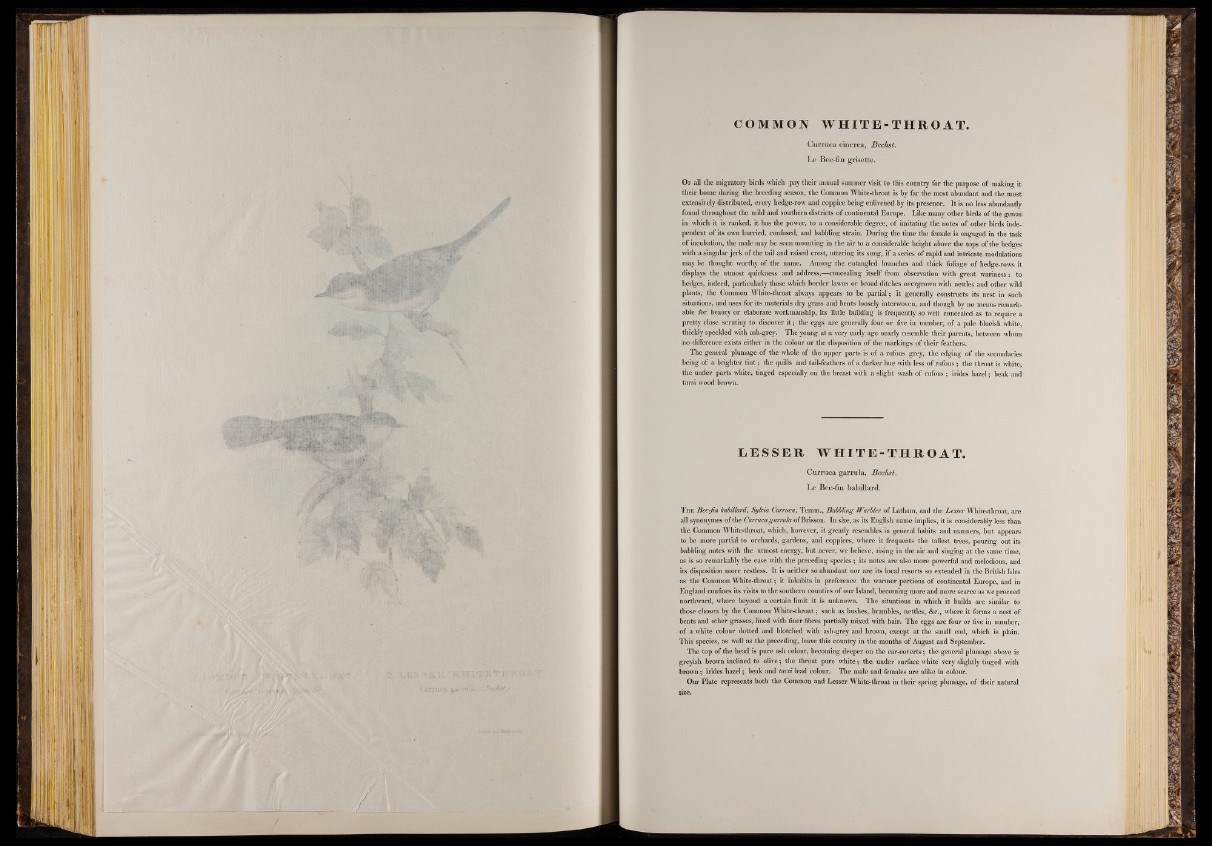
COMMON WH I T E - T H R O A T .
Curruca cinerea, Bechst.
Le Bec-fin grisette.
O f all the migratory birds which pay their annual summer visit to this country for the purpose of making it
their home during the breeding season, the Common White-throat is by far the most abundant and the most
extensively distributed, every liedge-row and coppice being enlivened by its presence. It is no less abundantly
found throughout the mild and southern districts of continental Europe. Like many other birds of the genus
in which it is ranked, it has the power, to a considerable degree, of imitating the notes of other birds independent
of its own hurried, confused, and babbling strain. During the time the female is engaged in the task
of incubation, the male may be seen mounting in the air to a considerable height above the tops of the hedges
with a singular jerk of the tail and raised crest, uttering its song, if a series of rapid and intricate modulations
may be thought worthy of the name. Among the eutangled branches and thick foliage of hedge-rows it
displays the utmost quickness and address,—concealing itself from observation with great wariness: to
hedges, indeed, particularly those which border lawns or broad ditches overgrown with nettles and other wild
plants, the Common White-throat always appears to be partial; it generally constructs its nest in such
situations, and uses for its materials dry grass and bents loosely interwoven, and though by no means remarkable
for beauty or elaborate workmanship, its little building is frequently so well concealed as to require a
pretty close scrutiny to discover it ; the eggs are generally four or five in number, of a pale blueish white,
thickly speckled with ash-grey. The young at a very early age nearly resemble their parents, between whom
no difference exists either in the colour or the disposition of the markings of their feathers.
The general plumage of the whole of the upper parts is of a rufous grey, the edging of the secondaries
being of a brighter tint; the quills and tail-feathers of a darker hue with less of rufous; the throat is white,
the under parts white, tinged especially on the breast with a slight wash of rufous ; irides hazel; beak and
tarsi wood brown.
L E S S E R W H I T E - T H R O A T .
Curruca garrula, Bechst.
Le Bec-fin babillard.
T h e Bec-fin babillard, Sylvia Curruca, Temm., Babbling Wardler of Latham, and the Lesser White-throat, are
all synonymes of the Curruca garrula ofBrisson. In size, as its English- name implies, it is considerably less than
the Common White-throat, which, however, it greatly resembles in general habits and manners, but appears
to be more partial to orchards, gardens, and coppices, where it frequents the tallest trees, pouring out its
babbling notes with the utmost energy, but never, we believe, rising in the air and singing at the same time,
as is so remarkably the case with the preceding species; its notes are also more powerful and melodious, and
its disposition more restless. It is neither so abundant nor are its local resorts so extended in the British Isles
as the Common White-throat; it inhabits in preference the warmer portions of continental Europe, and in
England confines its visits to the southern counties of our Island, becoming more and more scarce as we proceed
northward, where beyond a certain limit it is unknown. The situations in which it builds are similar to
those chosen by the Common White-throat; such as bushes, brambles, nettles, &c., where it forms a nest of
bents and other grasses, lined with finer fibres partially mixed with hair. The eggs are four or five in number,
of a white colour dotted and blotched with ash-grey and brown, except at the small end, which is plain.
This species, as well as the preceding, leave this country in the months of August and September.
The top of the head is pure ash colour, becoming deeper on the ear-coverts; the general plumage above is
greyish brown inclined to olive; the throat pure white; the under surface white very slightly tinged with
brown; irides hazel; beak and tarsi lead colour. The male and females are alike in colour.
Our Plate represents both the Common and Lesser White-throat in their spring plumage, of their natural
size.